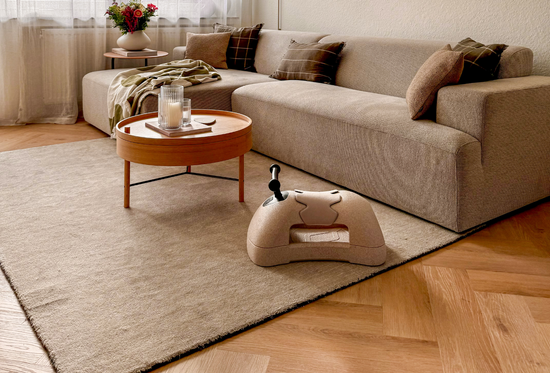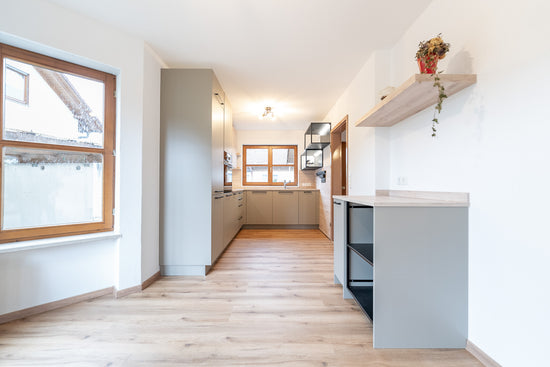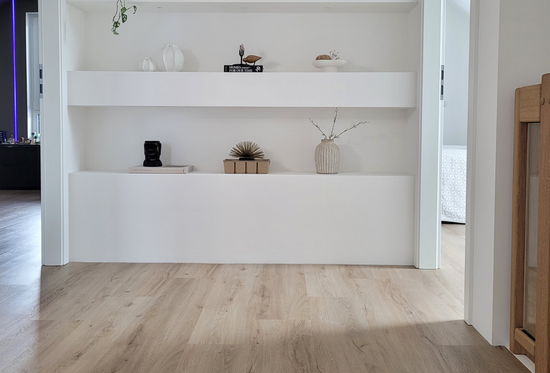Table of contents
- Introduction
- Introduction to Vollvinyl
- Introduction to SPC Vinyl
- Comparison of features
- Applications of solid vinyl and SPC vinyl
- Conclusion for decision-making
- Tips for choosing the right vinyl floor
The choice of flooring is more than just a matter of taste – it’s about comfort, durability, and adapting to your living conditions. Among the many options, solid vinyl and SPC vinyl have emerged as particularly popular. But what exactly are the differences, and which floor suits your needs best? In this floor guide you will find all the important information to make the right decision.
What is solid vinyl?
Solid vinyl, also known as homogeneous vinyl, consists of a single layer of vinyl throughout. It is soft underfoot and offers pleasant flexibility when walking. Its homogeneous structure makes it particularly resistant to wear, and small scratches are less noticeable.
Advantages of solid vinyl:
- Pleasantly soft and warm underfoot
- Scratches and wear marks are less visible
- Easy to install
- Wide range of designs
Disadvantages of solid vinyl:
- Can give way under heavy furniture
- Less dimensionally stable with temperature changes
What is SPC Vinyl?
SPC Vinyl, short for Stone Plastic Composite, consists of multiple layers, with the core layer made from a combination of limestone and plastics. This composition makes SPC Vinyl extremely stable and resistant to temperature fluctuations and moisture.
Advantages of SPC Vinyl:
- Very dimensionally stable, even with temperature changes
- Water-repellent and perfect for damp rooms
- Extremely durable and scratch-resistant
- Can be installed over existing floor coverings
Disadvantages of SPC vinyl:
- Feels harder and offers less comfort
- Can be more difficult to install
Comparison of features
-
Durability: Solid vinyl is robust and long-lasting, but SPC vinyl goes a step further – it is even more resistant to dents and scratches thanks to its hard core layer.
-
Comfort: Solid vinyl scores with its softness and comfort, while SPC vinyl is firmer and thus less yielding.
-
Moisture resistance: SPC vinyl is the better choice for damp rooms as it repels water better.
-
Installation: Both floor types are suitable for floating installation, but SPC can be challenging due to its stiffness.
-
Cost: SPC vinyl is generally more expensive than solid vinyl, due to its improved composition and durability.
Areas of application
- Solid vinyl is ideal for living areas where coziness matters, such as bedrooms and living rooms.
- SPC vinyl is excellent for places that require durable flooring, such as kitchens, bathrooms, and entryways.
Conclusion
Whether you choose solid vinyl or SPC vinyl depends on your individual requirements. If you want it cozy and value a warm feel underfoot, solid vinyl might be your first choice. However, if you need a floor that withstands a lot, reacts little to moisture, and does not warp, then SPC vinyl is the better option. Both materials offer a wide range of designs and can greatly enhance the appearance of your rooms.
Tips for selection
- Consider how the room is used to select the appropriate vinyl flooring.
- Consider the climate in your area; in regions with strong temperature fluctuations, SPC vinyl might be better.
- Think about the long-term costs; a more durable floor like SPC could be cheaper in the long run since you will spend less on replacement and repairs.
With this information, you are now well equipped to make a choice that is not only visually appealing but also functionally suits your lifestyle.





